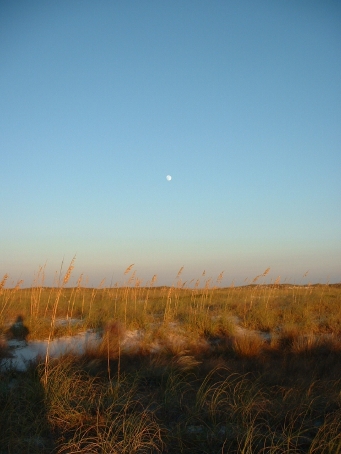St. George Island
Dune Vegetation Dynamics

Figure 1. (A) St. George Island is approximately 5 km offshore along the Gulf coast of Florida.
(B) The six census grids at the very easternmost tip of the island. (Source: Google Earth).
Long-term monitoring of vegetation dynamics on St. George Island
For the last 16 years, the Miller Lab has been working on various aspects of the vegetation on the eastern tip of St. George Island, Florida. St. George is a typical microtidal barrier island located on the Gulf Coast of the Florida panhandle. Its 48 km length and narrow width (0.5 to 2 km) are dominated by low tidal range waves and frequent overwash by storms. Habitats are determined by the island's characteristic low relief, with a fronting line of foredunes on the ocean side, behind which there is an extensive overwash flat, with older, more stable dunes and vegetation on the bayside.
We originally worked on the effects of competition and herbivory on Sebatia stellaris, an annual gentian, but we were immediately struck by the high year-to-year variation in not only mean plant size, but even the spatial location of populations. It became clear that most of the plant species exhibited similar high variation in occurrence across years and that at least part of this variation could be explained by the severity of the late-spring droughts and tropical storms in the summer and fall.
To elucidate these dynamics, we established at set of six 60 m x 60 m plots on the eastern tip of the island in 1998. Two plots were established each in the high but unstable front dunes, the lower-lying interdunal areas, and the rolling back dunes. Within each plot, we set up permanent markers every 10 m in a 7 x 7 grid. We have sampled a 1 m squared plot at each of the 294 grid points (6 plots x 49 points) since 1998 (Figure 1).
Some dynamics are apparent already. For example, Heterotheca subaxillaris is intolerant of saltwater inundation. Such species spread widely across the dunes between storms (such periods may last several years), only to be dramatically restricted to the highest dune areas or even totally eliminated following high storm surge. Other species are relatively robust and may be particularly important for dune recovery following hurricanes and other major storms.
In these pages, we describe our research and some results to date. We also provide a species list and partial access to our long-term data.
All questions about the content of these pages should be addressed to T. Miller, Dept. of Biological Sciences, Florida State University, Tallahassee, FL 32306 or e-mail at miller@bio.fsu.edu.
